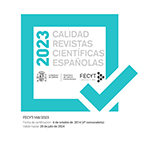Preguntas y respuestas sobre la gestación por sustitución: los estudios de opinión pública a revisión
Resumen
La gestación por sustitución es una práctica reproductiva que suscita una enorme controversia social, bioética, política y mediática pues socava los pilares canónicos que sostienen la institución familiar. En este artículo presentamos una revisión bibliográfica o Scoping Review de 29 artículos científicos que recogen estudios de opinión sobre esta materia. En ellos se aprecia la desaprobación social que, mayoritariamente, suscita la gestación por sustitución. Desde una perspectiva temporal, la tendencia es hacia su mayor aceptación. La población elige técnicas de reproducción asistida que garanticen el vínculo genético y que no impliquen la participación de terceros. En este sistema de preferencias, la subrogación es relegada socialmente al último lugar. Un número reducido de trabajos realizan análisis explicativos sobre los determinantes del nivel de aceptación de la subrogación. Temas controvertidos, como la subrogación comercial o cerrada, son escasamente incorporados en las encuestas de opinión pública. Cuando se interroga sobre la representación social de la mujer gestante, los marcos adoptados reproducen la imagen que proyectan los medios de comunicación obviando los hallazgos presentados tanto por la investigación etnográfica como por la interesada en evaluar los resultados de los acuerdos de subrogación. Los estudios de opinión enmarcan, mayoritariamente, la opinión de la población en un contexto médico. Los artículos que indagan sobre el grado de aceptación de la subrogación por causas “sociales” son excepcionales, a pesar de que el propio desarrollo de las técnicas de reproducción asistida se produce paralelamente a la emergencia de nuevas formas familiares.
Descargas
Descarga artículo
Licencia
La revista Política y Sociedad, para fomentar el intercambio global del conocimiento, facilita el acceso sin restricciones a sus contenidos desde el momento de su publicación en la presente edición electrónica, y por eso es una revista de acceso abierto. Los originales publicados en esta revista son propiedad de la Universidad Complutense de Madrid y es obligatorio citar su procedencia en cualquier reproducción total o parcial. Todos los contenidos se distribuyen bajo una licencia de uso y distribución Creative Commons Reconocimiento 4.0 (CC BY 4.0). Esta circunstancia ha de hacerse constar expresamente de esta forma cuando sea necesario. Puede consultar la versión informativa y el texto legal de la licencia.











